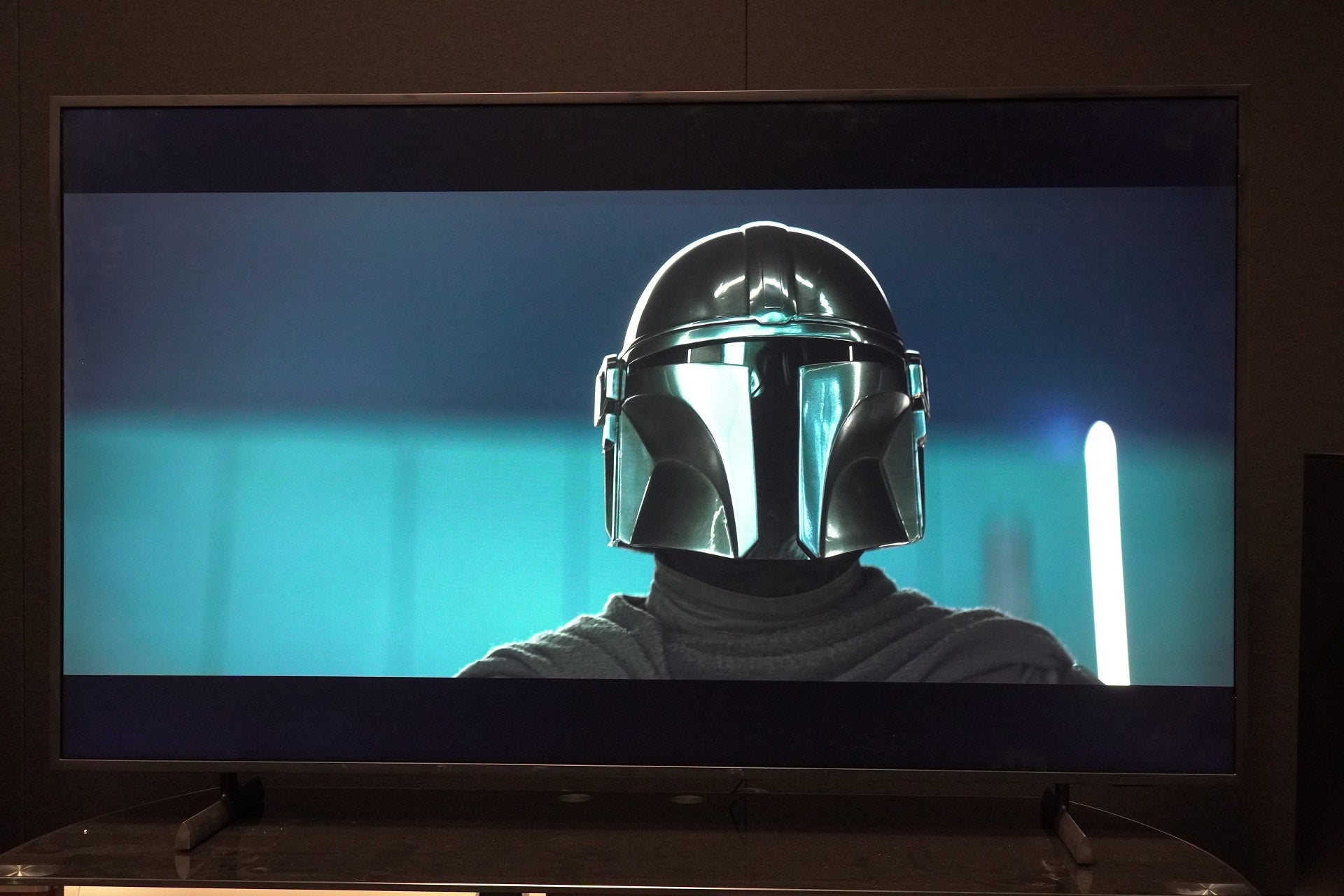Verdict
A TV for those with artistic tastes, Samsung’s The Frame (2022) is both a fine-looking and a fine-performing TV, with a matte display that stops reflections from becoming an irritant. It is relatively expensive compared to the higher-performing Neo QLED models.
Pros
- Good HDR performance
- Matte display reduces reflections
- Easy to assemble and customisable design
- Good gaming features
- One Connect box offers neater installation
Cons
- Sluggish user interface
- Similarly priced to Neo QLEDs
- Limited black levels
Availability
- UKRRP: £1099
- USARRP: $1499
- EuropeTBC
- CanadaRRP: CA$1999
- AustraliaRRP: AU$2099
Introduction
We’ve mentioned many times that Samsung makes TVs for all types of people. If you’re a gamer, Samsung has a TV for you; if you want cutting-edge TV tech, there’s 8K, and if you’re a connoisseur of art there’s The Frame.
The Frame is a TV and yet not a TV. Samsung has long been bothered about what happens when you turn a telly off with that black void in the centre of the room.
In Samsung’s mind The Frame becomes part of a room’s furniture, but for all its artistic sensibilities, it still has to perform like a TV.
Design
- Slim chassis
- Supports One Connect box
- Matte display reduces screen glare
The Frame’s has a depth of just 24.9mm – slimmer than most OLED screens. The rear panel is also uniformly flat, which helps it sit flush against the wall if the preference is to wall-mount, a design feature that’s aided and abetted by Samsung’s One Connect box.
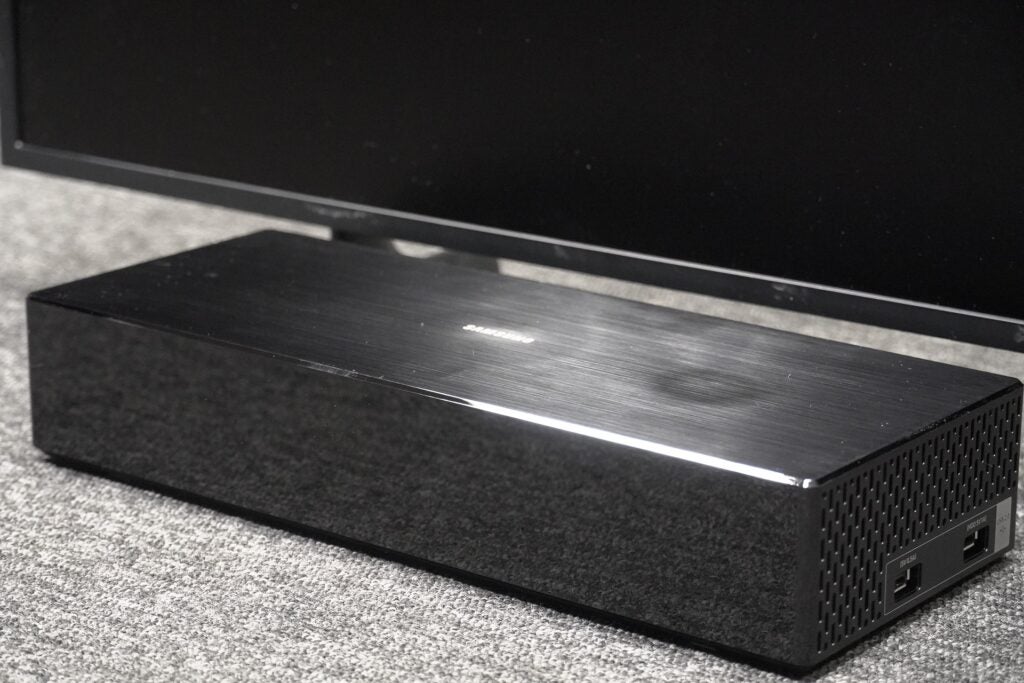
The One Connect features all the TV’s processing units and connections in a separate box: power, picture, and audio fed to the TV via a slim cable. It’s a brilliant means of keeping cable clutter away from the TV, though attaching the cable to the tellies’ rear is a fiddle.
If you choose not to wall mount, feet are provided that can be easily clipped on. The lack of any screws makes it a simple and quick assembly process. The bezels can also be customised with different colours available, and there’s another stand option in the three-legged Studio stand.
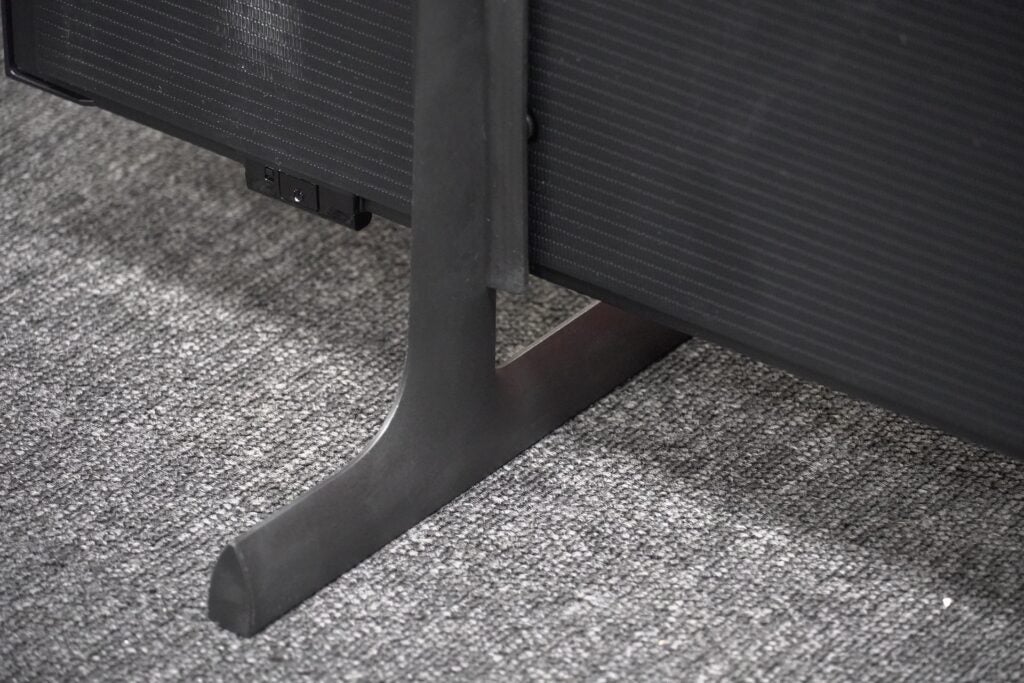
The screen is an edge-lit one, which means the LEDs in the backlight are placed around the edges. This keeps the TV slim but affects picture quality as I’ll get to later. As The Frame also uses a VA panel, contrast and black levels should be higher though the weakness of VA panels lies in their viewing angles. Samsung has boosted this with its Wide Angle Viewing tech.
The Frame (2022)’s screen also features an excellent glare free matte display. Shine a light on the screen and the display diffuses and refracts the light so it has less impact. I found it a blessing many times given the test room’s bright lights; The Frame is the one TV where reflections have been batted away with ease.
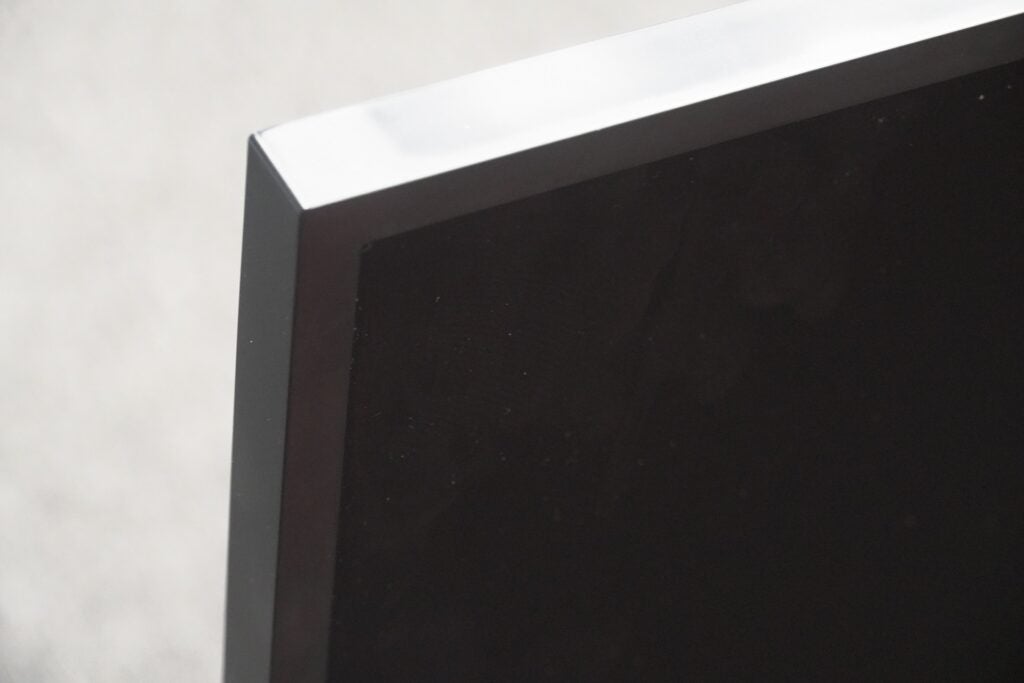
Tizen interface
- Sluggish in instances
- Ton of streaming apps
- Plenty of free content
This is the same Tizen smart interface Samsung revamped in 2022, and it still suffers from issues I’ve noted in several other reviews. It’s sluggish to respond, especially with the smart remote but on occasion with the ‘normal’ remote, most noticeable during start up or after exiting an app.
Tizen also suffers from a rather haphazard organization. Features such as Multi View are hidden away to the point where I wonder why they’re even advertised.
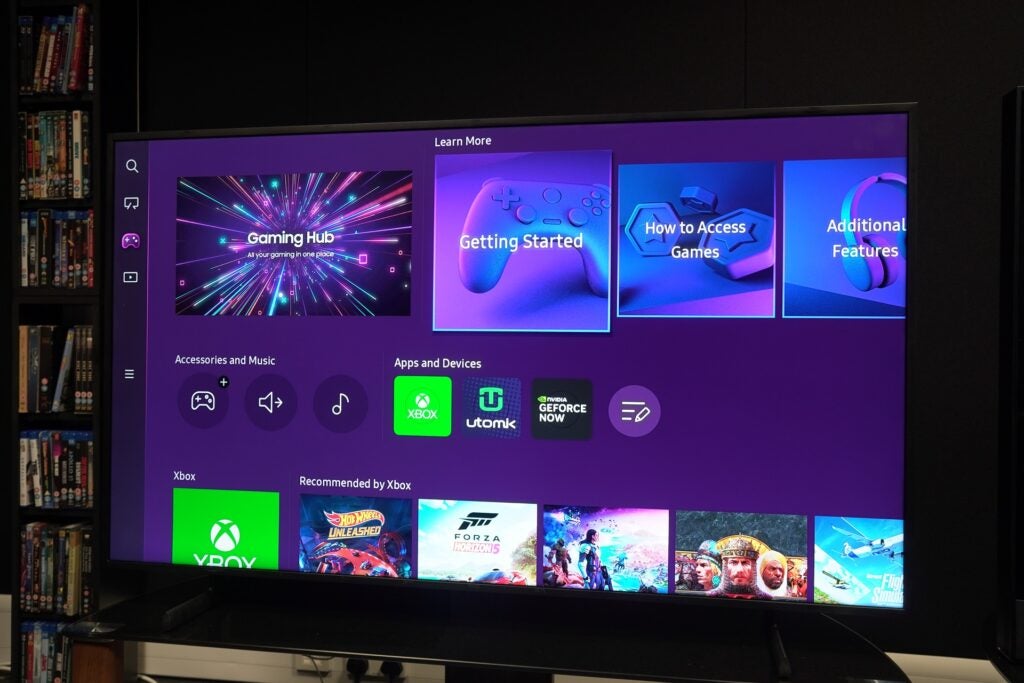
The interface is divided into hubs: Media for streaming apps/curated content/inputs, Search, Art Mode (more on that later), and Gaming. Gaming is where you can control apps and accessories (such as adding controllers), with access to cloud gaming apps such as Xbox Game Pass, GeForce Now, and Utomik.
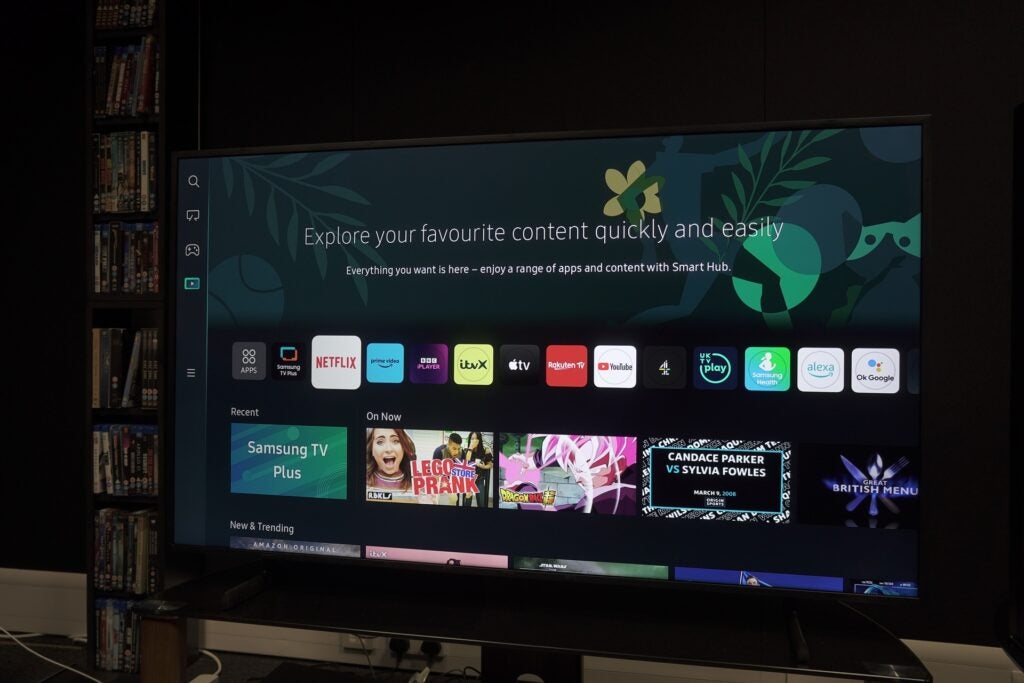
When it comes to app availability there are few that top Tizen. From the individual UK catch up and on-demand apps to the likes of Netflix, Prime Video, Disney+ to Spotify, Tidal, and Apple Music, there’s a massive amount of breadth to its options. If paid-for access to content isn’t what you’re after, you’re covered by Samsung TV Plus, a free-to-access streaming-based service as well as movies from Plex.
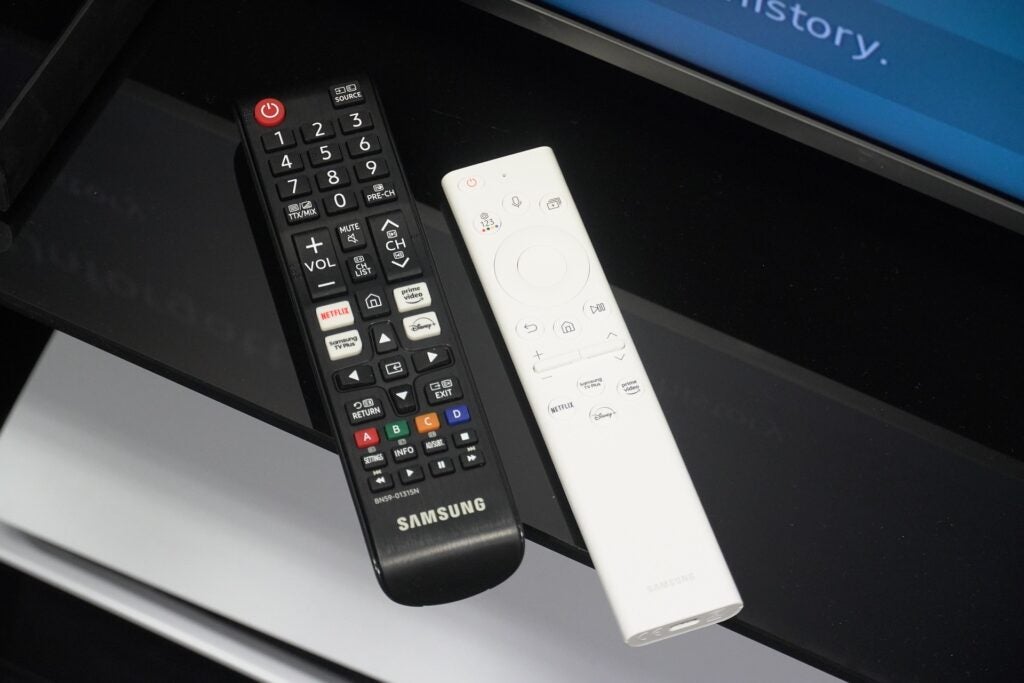
Operation is via a minimalist remote that features a solar cell that soaks up ambient light to charge itself (or you can plug it into a USB-C port), as well as the standard remote that includes ‘all’ the buttons. It’s a bit busy and might be tricky to use for those with bigger digits.
Features
- 4K/120Hz gaming support
- Art mode
- Alexa, Bixby and Google voice assistants
Surprisingly for a lifestyle TV, The Frame (2022) is stocked with features expected from a Samsung Neo QLED. Indeed, it’s not far off the QN95B in the area it covers.
Connectivity covers four HDMI inputs, with HDMI 4 designated as the HDMI 2.1 input with support for 4K/120Hz frame rates (despite the screen only being 100Hz). Other features from the 2.1 standard include eARC (for passing through high quality audio to a soundbar), auto low latency mode (for switching the TV into its game mode) and variable refresh rates (to improve gaming fidelity).
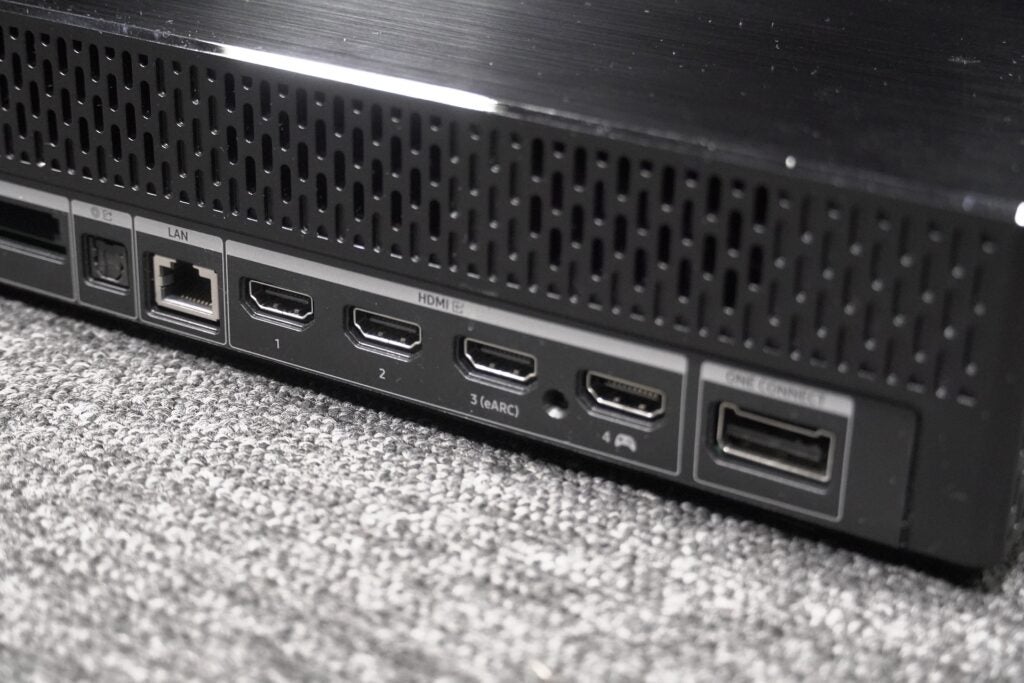
Two USB, Ethernet, digital optical out, CI+ 1.4, two RF antenna inputs, as well as Wi-Fi and Bluetooth 5.2 make up the rest of the connection options.
Given the art focus, you might think The Frame would give gaming a wide berth but that’s not the case. I measured input as 11.8ms – not the fastest Samsung but better than most of the competition – and with its Game Motion Plus mode, which improves the image quality at a cost to latency, it’s 13.8ms. Again, not too shabby in the grand scheme of things.
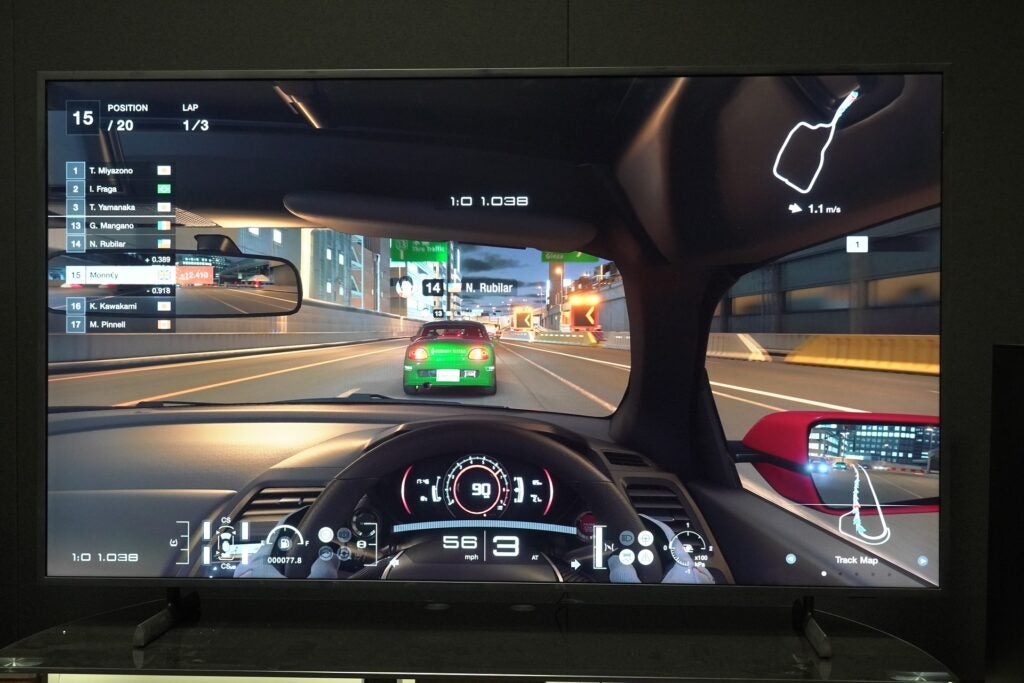
There’s support for HDMI VRR for console gamers and AMD FreeSync Premium Pro for PC. Though Samsung doesn’t officially support Nvidia G-Sync, you can at least use it with this TV.
On the voice assistant front there’s Amazon Alexa and Google Assistant support, as well as Samsung’s own Bixby for search. Samsung’s SmartThings integrates the TV within a smart home set-up, and it’s also helpful in quickly setting up the TV for initial use.
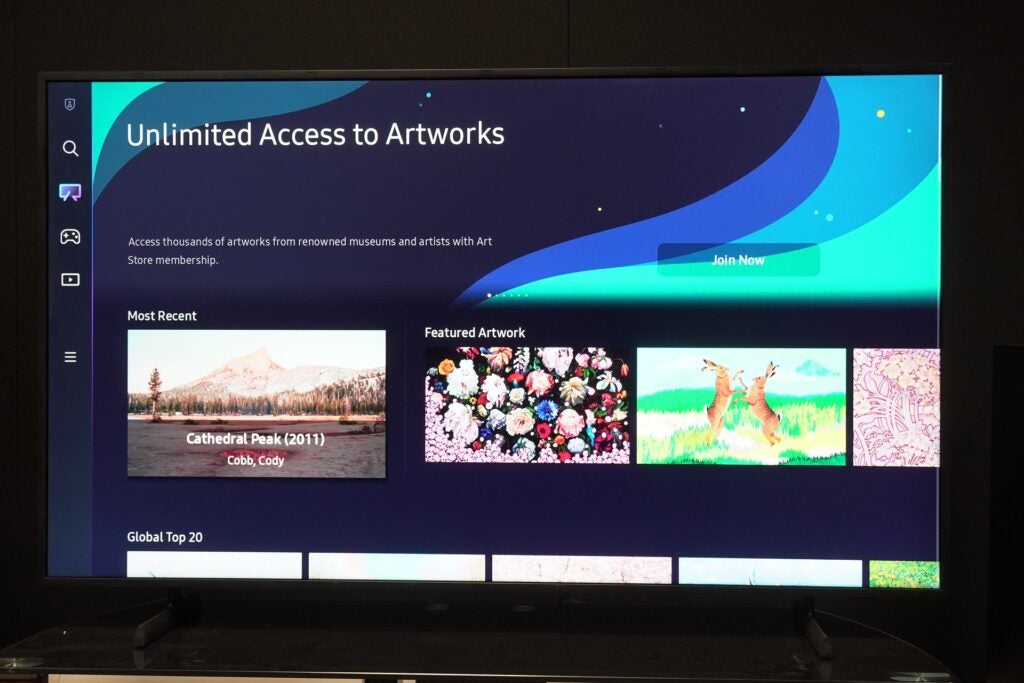
Then, of course, there’s Art Mode. While most Samsung TVs support this feature in some way or other, it’s inherent to The Frame’s purpose. Art does look fantastic on this TV; the lack of reflection focuses the reviewer on the screen.
There’s a selection of art to peruse through and you can also buy pieces of art and effectively ‘hang’ them up. It’s worth noting that hitting the off button doesn’t turn the TV off but puts it into Art Mode. A hold turns the TV off completely.
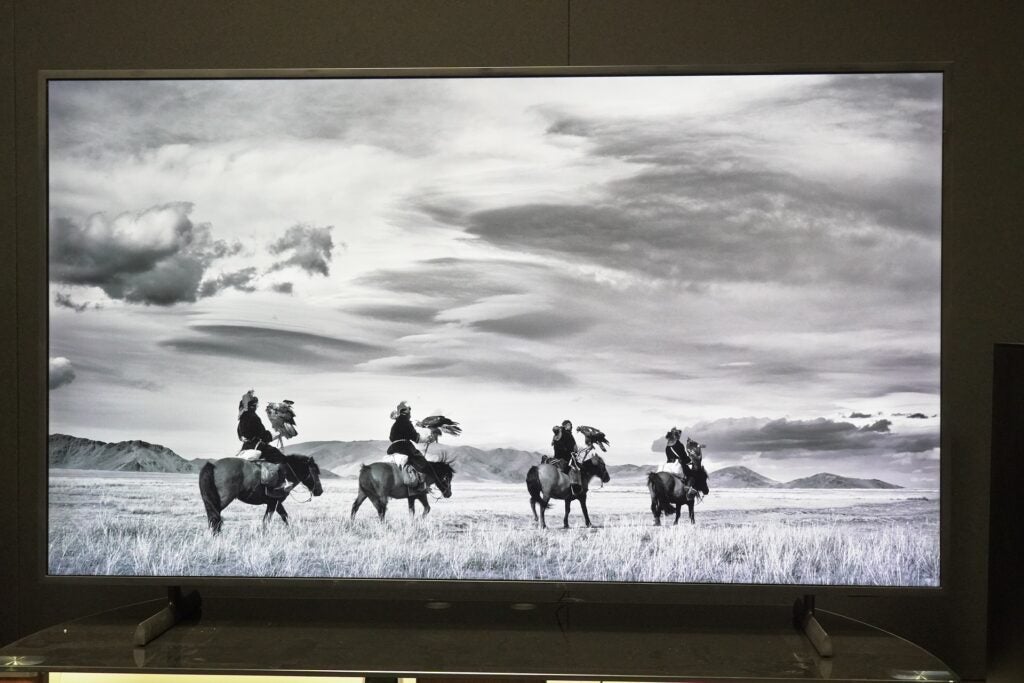
Picture Quality
- No Dolby Vision support
- Solid brightness for HDR content
- Colours are wide-ranging and punchy
Dual LED, LED LCD, QLED, edge-lit dimming system, VA panel – these are all technologies The Frame supports, and it can be easy to get bogged down in all the acronyms, but the result is The Frame puts in an enjoyable performance across a range of resolutions.
Black depth, especially with HDR content, has its limits, evident from the opening credits of The Martian in 4K HDR as the solidity and depth found with OLED screens aren’t present. The TV’s control over brightness and black levels with its edge-lit dimming system is fair though, and The Frame can provide levels of good contrast where required, though there are some blue-ish tones in the black borders.
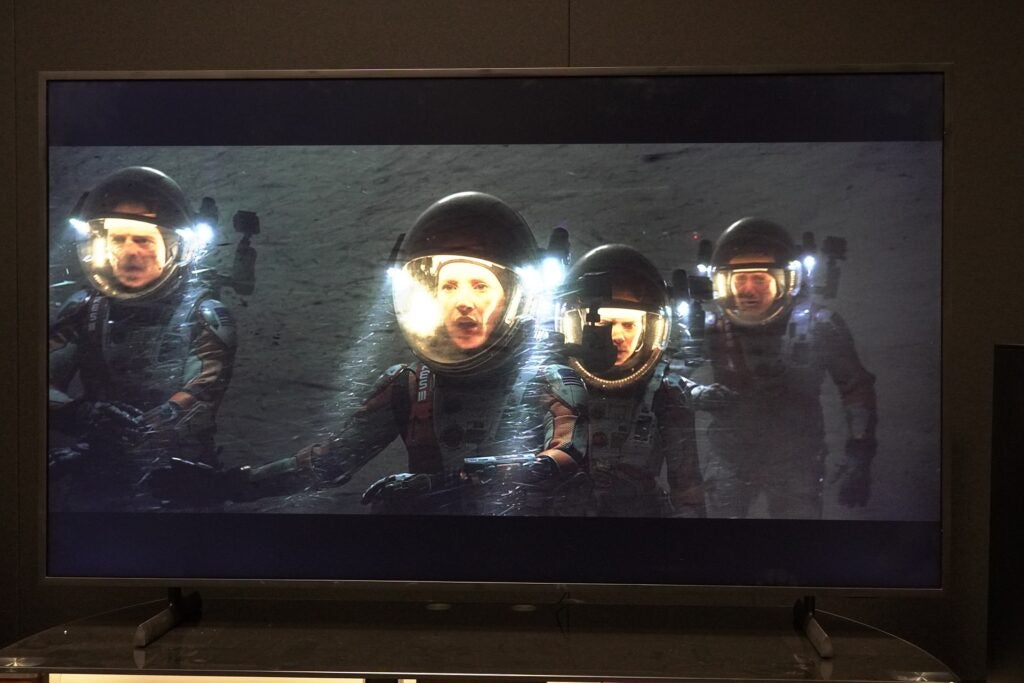
But for the most part, black levels, while not inky in their blackness, are stronger than anticipated. The scene in The Martian where the astronauts are forced to evacuate shows those black levels and contrast to be solid. The lights of their visors against the night sky doesn’t result in any distracting blooming, and while the black levels perhaps aren’t strong enough to create a fully three-dimensional image, there is a sense of depth to the image only possible with HDR content.
Peak brightness with HDR content is consistent across picture modes. In the Standard preset I measured it at 667 nits on a 10% patch, while Dynamic is only slightly brighter at 670 nits. That’s enough to give a good account of HDR, and along with the QLED panel, The Frame (2022) describes the various hues of Martian landscape with skill. Yes, it’s mostly red, but the variations of it from orangey-red, to rich or rusty tones is well defined.
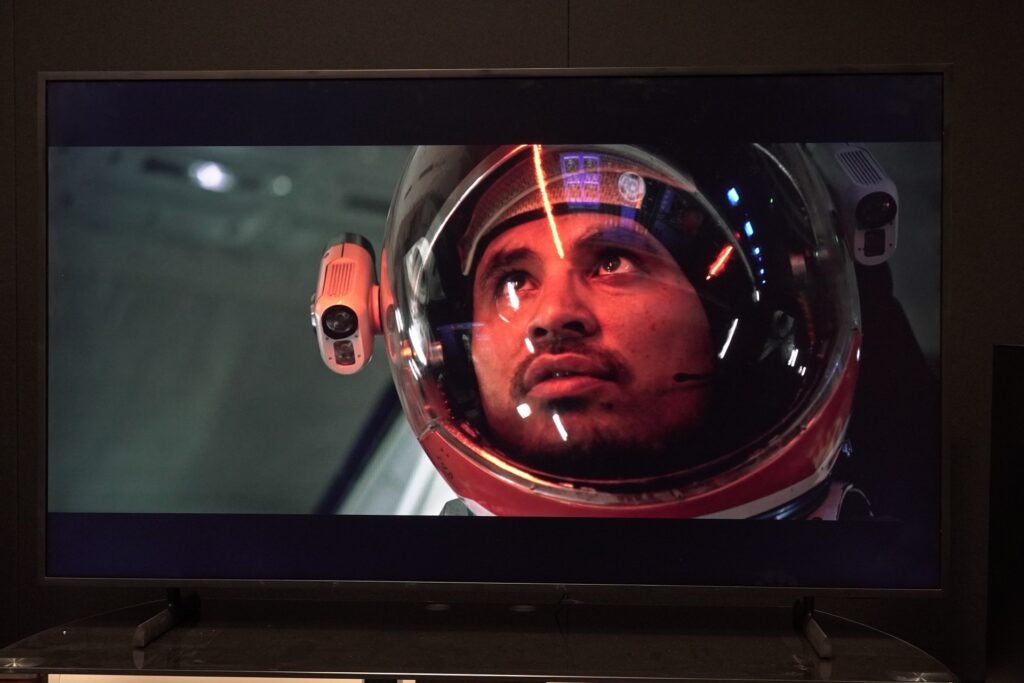
More than anything, this feels and looks like the type of image you’d get from Samsung’s Neo QLED TVs. There’s punchiness to colours that’s allied with a wide scope to the colour range – nothing is overstated (at least not in Movie or Filmmaker mode); and the levels of fine detail from the grains of sand to the setting of the ‘Hab’ or the materials of the spacesuits holds up excellently on this 55-inch screen. It’s a clean, sharp (but not overly) and finely detailed image.
Switching to a 4K Blu-ray of Bad Times at the El Royale, there are some key but subtle differences between the HDR10 and HDR10+. Shadow detail is better, allowing a better peak into darker scenes, such as when John Hamm’s character starts poking around the hotel’s hidden areas.
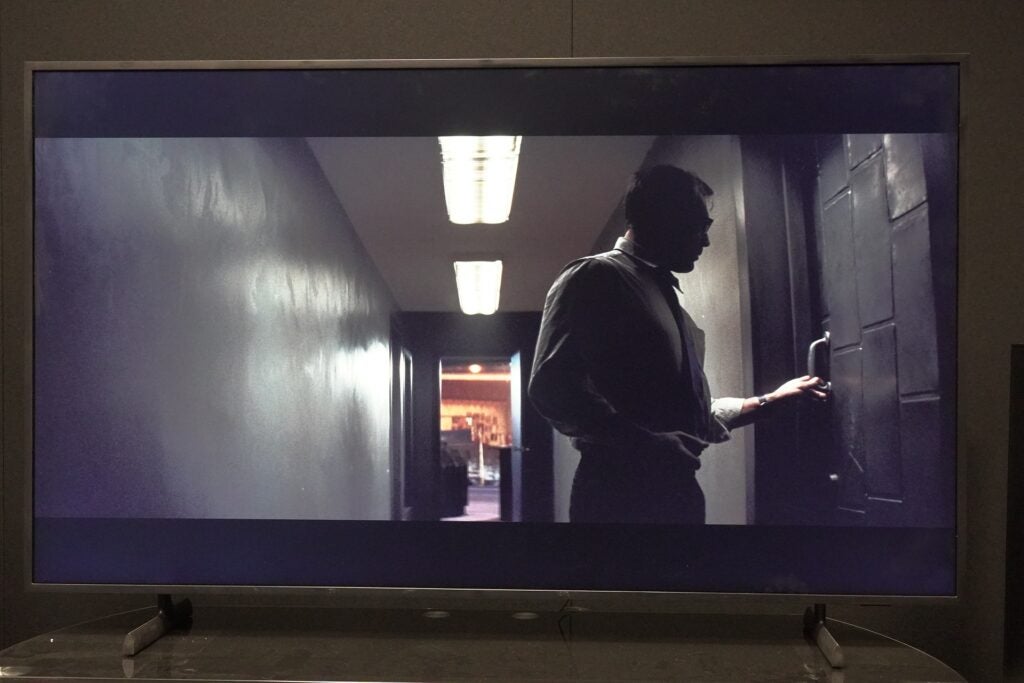
With HDR10+, the film is also slightly brighter, the colours a little richer and the darker parts of the film are described with more depth. In HDR10 these same moments can look slightly muddied or weaker, like the absence of the dark, defined patches on Hamm’s face during a phone call.
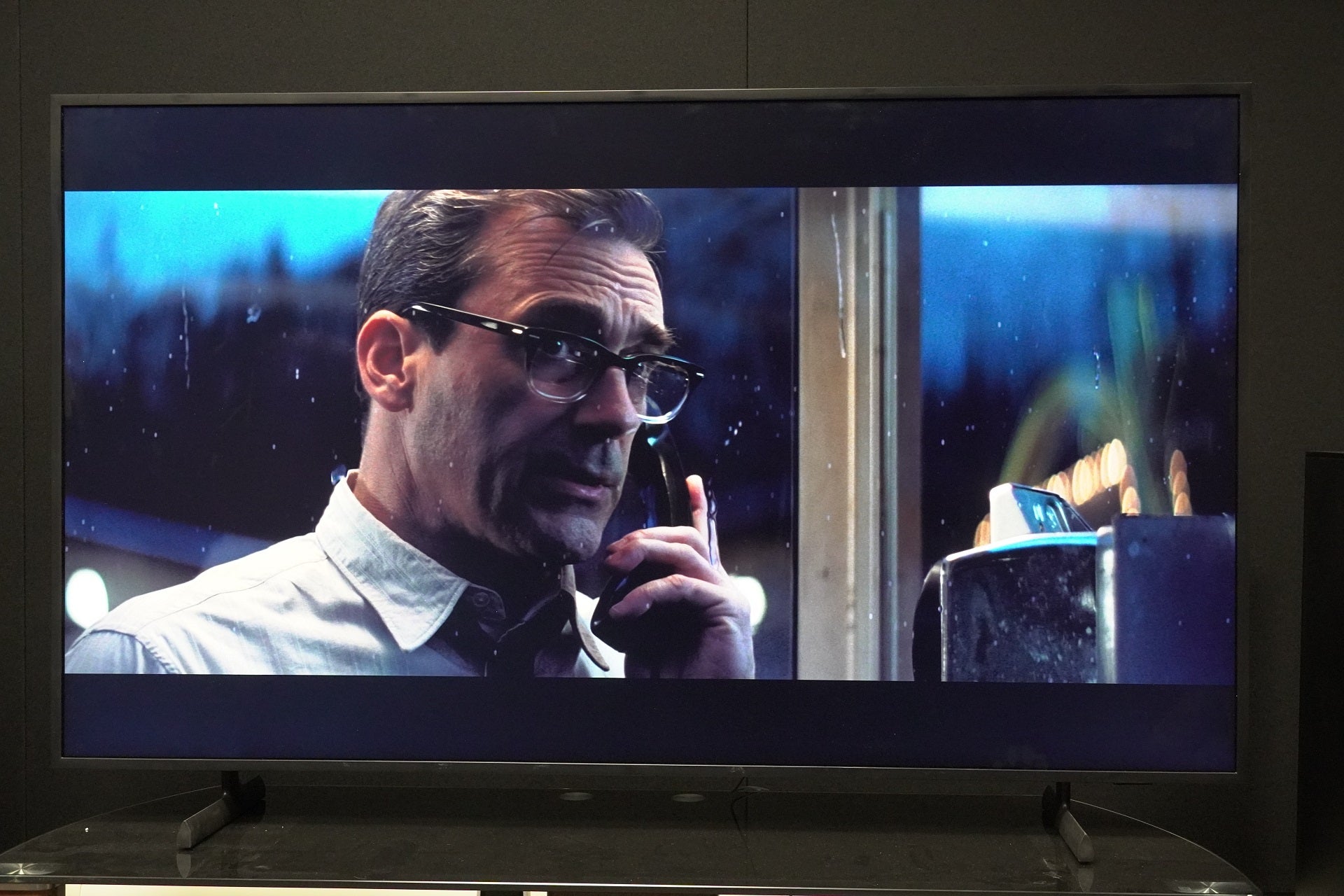
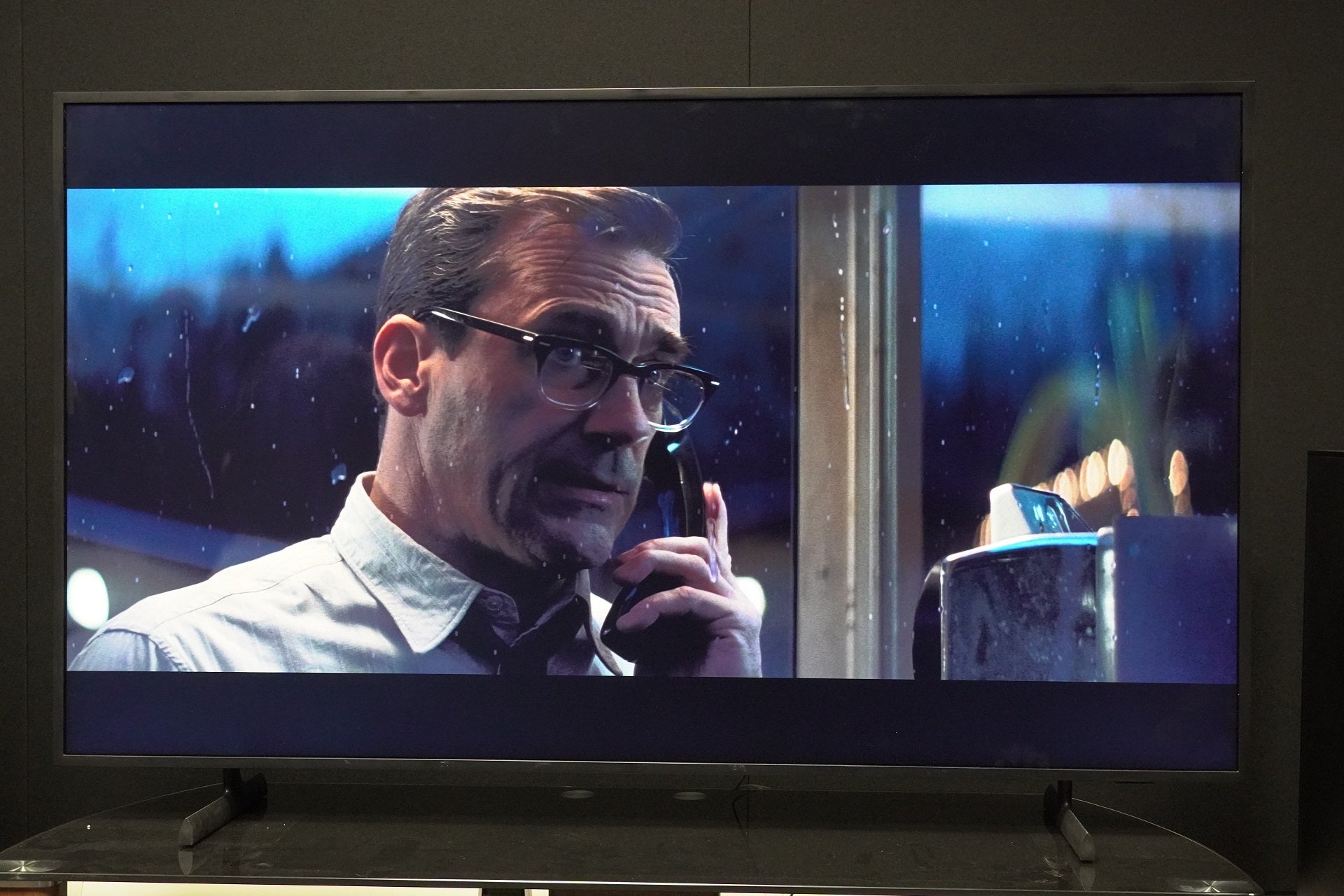
Moving to a Blu-ray of John Wick, The Frame’s upscaling is as strong as I’d expect from a Samsung set. There are satisfactory levels of detail, clarity, and sharpness – the film’s strong sense of colour comes through but in a natural manner and not overly boosted.
Colours have plenty of punch and strength, like the red shirt Viggo wears, and the film’s contrast-heavy approach is one that The Frame brings out well. Detail in the faces of the actors is strong, revealing blemishes, creases, and fine detail in facial hair. It’s a fine looking image.
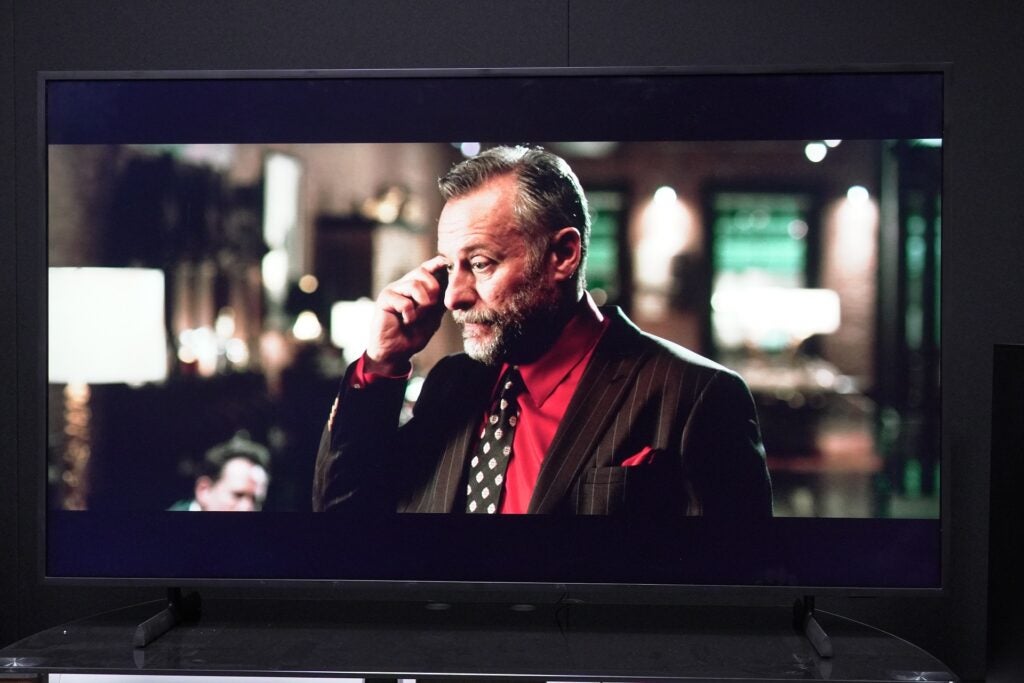
Dropping to standard definition and a DVD of Drive and there’s no doubt it’s a soft-looking image but better than expected. There’s a lack of sharpness but decent enough detailing to clothes and environments. Colours are both strongly reproduced and wide ranging in scope, the neon-soaked visuals are entertainingly brought to life.
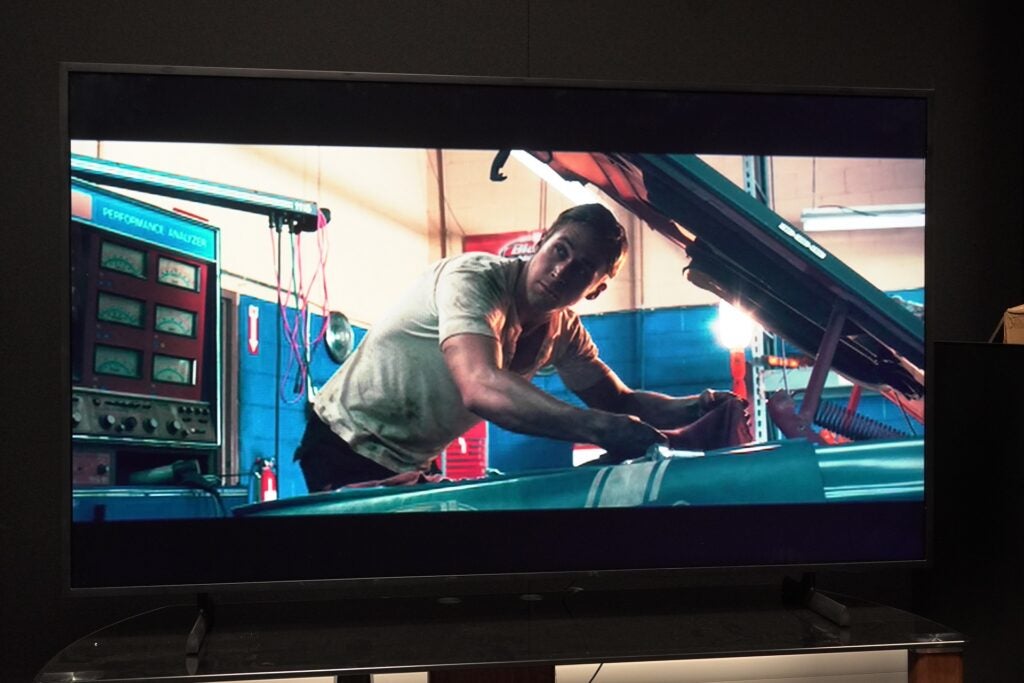
Skin tones appear natural to the source and black levels are strong. There’s depth to the image as well, the brightness in some scenes almost feels HDR in description. There’s also a little backlight bleeding, as well as some local dimming, which is unusual considering this is SDR content. Nevertheless, this film looks much better than I would have expected, and noise is massaged well to not be a distraction.
The Frame’s motion processing hews similar to the rest of Samsung’s TVs. Apply the Auto setting and there’s a fuzzy sense of motion as well as the presence of judder with more dynamic movement. It’s not as sharp or as clear with noticeable instances of judder and screen tears in fast-moving scenes. With slower-paced it’s fine, but that Soap Opera Effect is still evident.

It’s better to switch it off or switch to Custom. The latter handles motion with more smoothness and clarity, maintaining the film’s 24fps appearance while reducing judder. The difference between this option and turning it off completely isn’t massive, so if you prefer not to have motion on, that’s what I’d recommend.
Sound Quality
- A choice of Standard or Amplify modes
- Decent sense of scale and vocal clarity
- OTS support
The overall theme thus far of The Frame has been one of welcome surprises, and that continues with the sound system. Packing 40W of power and Samsung’s OTS audio system, it’s a large sounding effort for a screen as slim as this.
Don’t take large to read as bigger than the TV itself, but whatever processing is being done, it contributes to soundtracks being more spacious than expected. The Amplify mode is the most energetic and dynamic mode – in Standard a series like The Mandalorian isn’t as energetic or has the same sense of scale. But the Amplify mode does invoke distortion with low frequencies, the bassy voices of the Mandalorian soldiers stress the speakers more.
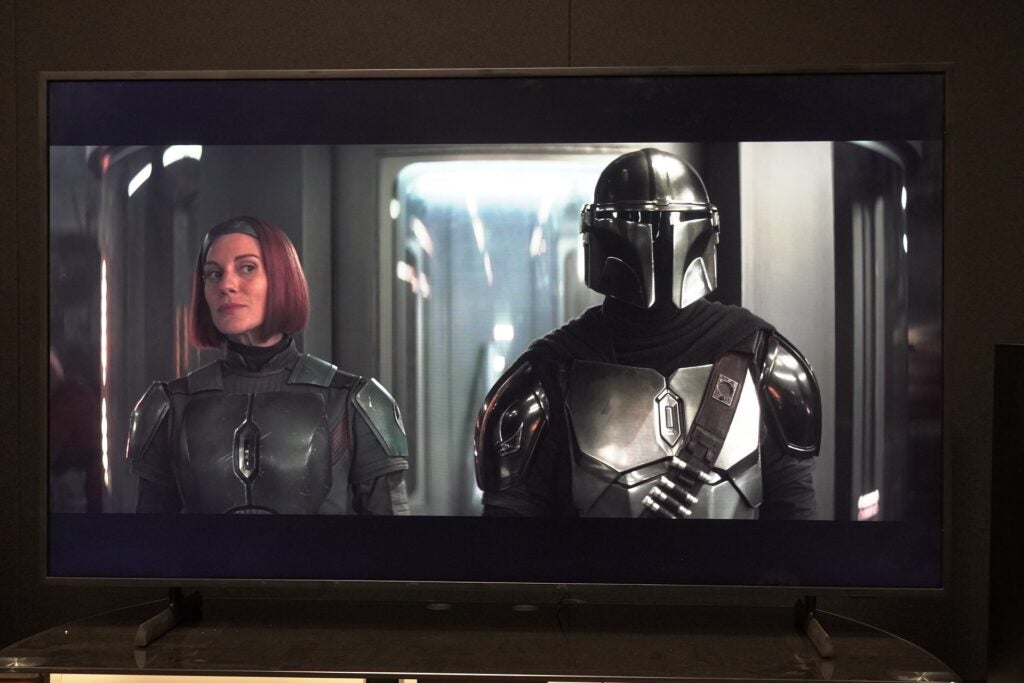
Vocal clarity is good, and sound effects have the uncanny knack of sounding where they are on screen, as does dialogue. There’s decent bass too, a good weighty thump is provided in some instances to the John Wick soundtrack, but nothing here that would make a soundbar envious.
Purchase a soundbar like the HW-S61B and it’d be an instant improvement and with Samsung soundbars you’ll also get the Q-Symphony feature that produces an even bigger audio performance.
Latest deals
Should you buy it?
If your tastes are artistic: The Art Mode combined with the matte display work well, making this TV an actual work of art.
There are better HDR sets available: If it’s HDR you’re interested in, the QN90B and QN95B are better options.
Final Thoughts
The Frame (2022) is a surprise, much like Samsung’s The Serif was when I reviewed it last year. The picture performance impresses, it is well covered for gaming, and the design is exceedingly simple, especially with its matte screen that reduces the impact of reflections.
Then there’s the Art mode, which is great if you’re an art connoisseur turning the TV into a proper frame if wall mounted.
But it costs around the same price as the Neo QLED QN90B/QN95B, both of which offer a stronger HDR performance. In fact, the price tag feels steep if you’re purely buying this TV for its art functions.
Considering its lifestyle ambitions, The Frame (2022) didn’t need to be as good or as well specified as it is. I’ve been a sceptic of Samsung’s TVs in the past, but this is a fine effort, particularly for those who want their TV to meld in with its surroundings. The Art Mode may even make you forget there’s a TV there in the first place.
How we test
We test every television we review thoroughly over an extended period of time. We use industry standard tests to compare features properly. We’ll always tell you what we find. We never, ever, accept money to review a product.
Find out more about how we test in our ethics policy.
FAQs
Yes, to view the full selection of art on the TV, you’d need to subscribe to the Art Store for £3.99/month.
Sustainability
Trusted Reviews’ holds the fact that global warming is not a myth as a core value and will continuously endeavour to help protect our planet from harm in its business practices.
As part of this mission, whenever we review a product we send the company a series of questions to help us gauge and make transparent the impact the device has on the environment.
We currently haven’t received answers to the questions on this product, but will update this page the moment we do. You can see a detailed breakdown of the questions we ask and why in our sustainability info page.
Jargon buster
QLED
QLED stands for Quantum-dot Light Emitting Diode. It’s a display technology that uses small particles (called Quantum Dots) made up of slightly different sizes that produce different wavelengths (colours) when light is shone through them. This filter helps to emit a brighter and wider gamut of colours than a conventional LED TV is capable of.
HDR10+
HDR10+ is a HDR format supported by Panasonic and Samsung as a free to use, open platform alternative to Dolby Vision. It adds dynamic metadata on top of the core HDR10 signal that tells a TV how it should adjust the brightness, colours and contrast of content for the most optimal picture quality.
Verdict
A TV for those with artistic tastes, Samsung’s The Frame (2022) is both a fine-looking and a fine-performing TV, with a matte display that stops reflections from becoming an irritant. It is relatively expensive compared to the higher-performing Neo QLED models.
Pros
- Good HDR performance
- Matte display reduces reflections
- Easy to assemble and customisable design
- Good gaming features
- One Connect box offers neater installation
Cons
- Sluggish user interface
- Similarly priced to Neo QLEDs
- Limited black levels
Availability
- UKRRP: £1099
- USARRP: $1499
- EuropeTBC
- CanadaRRP: CA$1999
- AustraliaRRP: AU$2099
Introduction
We’ve mentioned many times that Samsung makes TVs for all types of people. If you’re a gamer, Samsung has a TV for you; if you want cutting-edge TV tech, there’s 8K, and if you’re a connoisseur of art there’s The Frame.
The Frame is a TV and yet not a TV. Samsung has long been bothered about what happens when you turn a telly off with that black void in the centre of the room.
In Samsung’s mind The Frame becomes part of a room’s furniture, but for all its artistic sensibilities, it still has to perform like a TV.
Design
- Slim chassis
- Supports One Connect box
- Matte display reduces screen glare
The Frame’s has a depth of just 24.9mm – slimmer than most OLED screens. The rear panel is also uniformly flat, which helps it sit flush against the wall if the preference is to wall-mount, a design feature that’s aided and abetted by Samsung’s One Connect box.

The One Connect features all the TV’s processing units and connections in a separate box: power, picture, and audio fed to the TV via a slim cable. It’s a brilliant means of keeping cable clutter away from the TV, though attaching the cable to the tellies’ rear is a fiddle.
If you choose not to wall mount, feet are provided that can be easily clipped on. The lack of any screws makes it a simple and quick assembly process. The bezels can also be customised with different colours available, and there’s another stand option in the three-legged Studio stand.

The screen is an edge-lit one, which means the LEDs in the backlight are placed around the edges. This keeps the TV slim but affects picture quality as I’ll get to later. As The Frame also uses a VA panel, contrast and black levels should be higher though the weakness of VA panels lies in their viewing angles. Samsung has boosted this with its Wide Angle Viewing tech.
The Frame (2022)’s screen also features an excellent glare free matte display. Shine a light on the screen and the display diffuses and refracts the light so it has less impact. I found it a blessing many times given the test room’s bright lights; The Frame is the one TV where reflections have been batted away with ease.

Tizen interface
- Sluggish in instances
- Ton of streaming apps
- Plenty of free content
This is the same Tizen smart interface Samsung revamped in 2022, and it still suffers from issues I’ve noted in several other reviews. It’s sluggish to respond, especially with the smart remote but on occasion with the ‘normal’ remote, most noticeable during start up or after exiting an app.
Tizen also suffers from a rather haphazard organization. Features such as Multi View are hidden away to the point where I wonder why they’re even advertised.

The interface is divided into hubs: Media for streaming apps/curated content/inputs, Search, Art Mode (more on that later), and Gaming. Gaming is where you can control apps and accessories (such as adding controllers), with access to cloud gaming apps such as Xbox Game Pass, GeForce Now, and Utomik.

When it comes to app availability there are few that top Tizen. From the individual UK catch up and on-demand apps to the likes of Netflix, Prime Video, Disney+ to Spotify, Tidal, and Apple Music, there’s a massive amount of breadth to its options. If paid-for access to content isn’t what you’re after, you’re covered by Samsung TV Plus, a free-to-access streaming-based service as well as movies from Plex.

Operation is via a minimalist remote that features a solar cell that soaks up ambient light to charge itself (or you can plug it into a USB-C port), as well as the standard remote that includes ‘all’ the buttons. It’s a bit busy and might be tricky to use for those with bigger digits.
Features
- 4K/120Hz gaming support
- Art mode
- Alexa, Bixby and Google voice assistants
Surprisingly for a lifestyle TV, The Frame (2022) is stocked with features expected from a Samsung Neo QLED. Indeed, it’s not far off the QN95B in the area it covers.
Connectivity covers four HDMI inputs, with HDMI 4 designated as the HDMI 2.1 input with support for 4K/120Hz frame rates (despite the screen only being 100Hz). Other features from the 2.1 standard include eARC (for passing through high quality audio to a soundbar), auto low latency mode (for switching the TV into its game mode) and variable refresh rates (to improve gaming fidelity).

Two USB, Ethernet, digital optical out, CI+ 1.4, two RF antenna inputs, as well as Wi-Fi and Bluetooth 5.2 make up the rest of the connection options.
Given the art focus, you might think The Frame would give gaming a wide berth but that’s not the case. I measured input as 11.8ms – not the fastest Samsung but better than most of the competition – and with its Game Motion Plus mode, which improves the image quality at a cost to latency, it’s 13.8ms. Again, not too shabby in the grand scheme of things.

There’s support for HDMI VRR for console gamers and AMD FreeSync Premium Pro for PC. Though Samsung doesn’t officially support Nvidia G-Sync, you can at least use it with this TV.
On the voice assistant front there’s Amazon Alexa and Google Assistant support, as well as Samsung’s own Bixby for search. Samsung’s SmartThings integrates the TV within a smart home set-up, and it’s also helpful in quickly setting up the TV for initial use.

Then, of course, there’s Art Mode. While most Samsung TVs support this feature in some way or other, it’s inherent to The Frame’s purpose. Art does look fantastic on this TV; the lack of reflection focuses the reviewer on the screen.
There’s a selection of art to peruse through and you can also buy pieces of art and effectively ‘hang’ them up. It’s worth noting that hitting the off button doesn’t turn the TV off but puts it into Art Mode. A hold turns the TV off completely.

Picture Quality
- No Dolby Vision support
- Solid brightness for HDR content
- Colours are wide-ranging and punchy
Dual LED, LED LCD, QLED, edge-lit dimming system, VA panel – these are all technologies The Frame supports, and it can be easy to get bogged down in all the acronyms, but the result is The Frame puts in an enjoyable performance across a range of resolutions.
Black depth, especially with HDR content, has its limits, evident from the opening credits of The Martian in 4K HDR as the solidity and depth found with OLED screens aren’t present. The TV’s control over brightness and black levels with its edge-lit dimming system is fair though, and The Frame can provide levels of good contrast where required, though there are some blue-ish tones in the black borders.

But for the most part, black levels, while not inky in their blackness, are stronger than anticipated. The scene in The Martian where the astronauts are forced to evacuate shows those black levels and contrast to be solid. The lights of their visors against the night sky doesn’t result in any distracting blooming, and while the black levels perhaps aren’t strong enough to create a fully three-dimensional image, there is a sense of depth to the image only possible with HDR content.
Peak brightness with HDR content is consistent across picture modes. In the Standard preset I measured it at 667 nits on a 10% patch, while Dynamic is only slightly brighter at 670 nits. That’s enough to give a good account of HDR, and along with the QLED panel, The Frame (2022) describes the various hues of Martian landscape with skill. Yes, it’s mostly red, but the variations of it from orangey-red, to rich or rusty tones is well defined.

More than anything, this feels and looks like the type of image you’d get from Samsung’s Neo QLED TVs. There’s punchiness to colours that’s allied with a wide scope to the colour range – nothing is overstated (at least not in Movie or Filmmaker mode); and the levels of fine detail from the grains of sand to the setting of the ‘Hab’ or the materials of the spacesuits holds up excellently on this 55-inch screen. It’s a clean, sharp (but not overly) and finely detailed image.
Switching to a 4K Blu-ray of Bad Times at the El Royale, there are some key but subtle differences between the HDR10 and HDR10+. Shadow detail is better, allowing a better peak into darker scenes, such as when John Hamm’s character starts poking around the hotel’s hidden areas.

With HDR10+, the film is also slightly brighter, the colours a little richer and the darker parts of the film are described with more depth. In HDR10 these same moments can look slightly muddied or weaker, like the absence of the dark, defined patches on Hamm’s face during a phone call.


Moving to a Blu-ray of John Wick, The Frame’s upscaling is as strong as I’d expect from a Samsung set. There are satisfactory levels of detail, clarity, and sharpness – the film’s strong sense of colour comes through but in a natural manner and not overly boosted.
Colours have plenty of punch and strength, like the red shirt Viggo wears, and the film’s contrast-heavy approach is one that The Frame brings out well. Detail in the faces of the actors is strong, revealing blemishes, creases, and fine detail in facial hair. It’s a fine looking image.

Dropping to standard definition and a DVD of Drive and there’s no doubt it’s a soft-looking image but better than expected. There’s a lack of sharpness but decent enough detailing to clothes and environments. Colours are both strongly reproduced and wide ranging in scope, the neon-soaked visuals are entertainingly brought to life.

Skin tones appear natural to the source and black levels are strong. There’s depth to the image as well, the brightness in some scenes almost feels HDR in description. There’s also a little backlight bleeding, as well as some local dimming, which is unusual considering this is SDR content. Nevertheless, this film looks much better than I would have expected, and noise is massaged well to not be a distraction.
The Frame’s motion processing hews similar to the rest of Samsung’s TVs. Apply the Auto setting and there’s a fuzzy sense of motion as well as the presence of judder with more dynamic movement. It’s not as sharp or as clear with noticeable instances of judder and screen tears in fast-moving scenes. With slower-paced it’s fine, but that Soap Opera Effect is still evident.

It’s better to switch it off or switch to Custom. The latter handles motion with more smoothness and clarity, maintaining the film’s 24fps appearance while reducing judder. The difference between this option and turning it off completely isn’t massive, so if you prefer not to have motion on, that’s what I’d recommend.
Sound Quality
- A choice of Standard or Amplify modes
- Decent sense of scale and vocal clarity
- OTS support
The overall theme thus far of The Frame has been one of welcome surprises, and that continues with the sound system. Packing 40W of power and Samsung’s OTS audio system, it’s a large sounding effort for a screen as slim as this.
Don’t take large to read as bigger than the TV itself, but whatever processing is being done, it contributes to soundtracks being more spacious than expected. The Amplify mode is the most energetic and dynamic mode – in Standard a series like The Mandalorian isn’t as energetic or has the same sense of scale. But the Amplify mode does invoke distortion with low frequencies, the bassy voices of the Mandalorian soldiers stress the speakers more.

Vocal clarity is good, and sound effects have the uncanny knack of sounding where they are on screen, as does dialogue. There’s decent bass too, a good weighty thump is provided in some instances to the John Wick soundtrack, but nothing here that would make a soundbar envious.
Purchase a soundbar like the HW-S61B and it’d be an instant improvement and with Samsung soundbars you’ll also get the Q-Symphony feature that produces an even bigger audio performance.
Latest deals
Should you buy it?
If your tastes are artistic: The Art Mode combined with the matte display work well, making this TV an actual work of art.
There are better HDR sets available: If it’s HDR you’re interested in, the QN90B and QN95B are better options.
Final Thoughts
The Frame (2022) is a surprise, much like Samsung’s The Serif was when I reviewed it last year. The picture performance impresses, it is well covered for gaming, and the design is exceedingly simple, especially with its matte screen that reduces the impact of reflections.
Then there’s the Art mode, which is great if you’re an art connoisseur turning the TV into a proper frame if wall mounted.
But it costs around the same price as the Neo QLED QN90B/QN95B, both of which offer a stronger HDR performance. In fact, the price tag feels steep if you’re purely buying this TV for its art functions.
Considering its lifestyle ambitions, The Frame (2022) didn’t need to be as good or as well specified as it is. I’ve been a sceptic of Samsung’s TVs in the past, but this is a fine effort, particularly for those who want their TV to meld in with its surroundings. The Art Mode may even make you forget there’s a TV there in the first place.
How we test
We test every television we review thoroughly over an extended period of time. We use industry standard tests to compare features properly. We’ll always tell you what we find. We never, ever, accept money to review a product.
Find out more about how we test in our ethics policy.
FAQs
Yes, to view the full selection of art on the TV, you’d need to subscribe to the Art Store for £3.99/month.
Sustainability
Trusted Reviews’ holds the fact that global warming is not a myth as a core value and will continuously endeavour to help protect our planet from harm in its business practices.
As part of this mission, whenever we review a product we send the company a series of questions to help us gauge and make transparent the impact the device has on the environment.
We currently haven’t received answers to the questions on this product, but will update this page the moment we do. You can see a detailed breakdown of the questions we ask and why in our sustainability info page.
Jargon buster
QLED
QLED stands for Quantum-dot Light Emitting Diode. It’s a display technology that uses small particles (called Quantum Dots) made up of slightly different sizes that produce different wavelengths (colours) when light is shone through them. This filter helps to emit a brighter and wider gamut of colours than a conventional LED TV is capable of.
HDR10+
HDR10+ is a HDR format supported by Panasonic and Samsung as a free to use, open platform alternative to Dolby Vision. It adds dynamic metadata on top of the core HDR10 signal that tells a TV how it should adjust the brightness, colours and contrast of content for the most optimal picture quality.



















